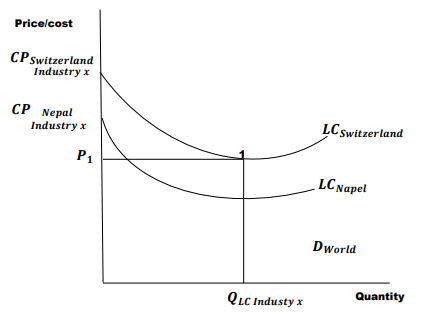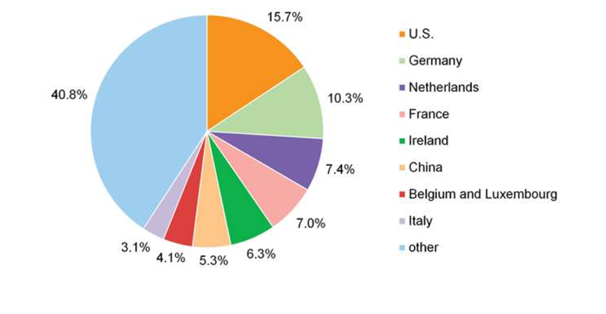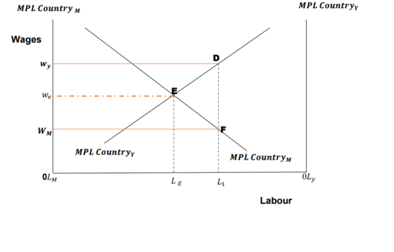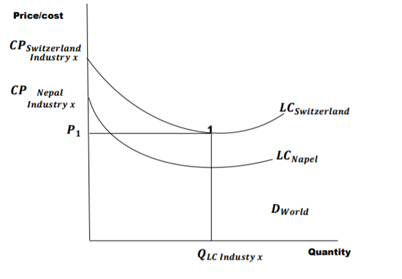Critical Discussion On International Trade & Enterprise Policy
Question
Task:
The questions to be answered are;
Question 1: World Trade Overview and Gravity Model
In the 19th Century Britain was trading with countries from distant locations such as North America, Latin America, Africa and Asia. Today, Britain mostly trades with European countries. Examine the causes of the British changing trade pattern with reference to the Gravity Model.
Question 2: Resources and Trade:
Heckscher-Ohlin (H-O) Model
How does the Ricardian model differ from the H-O theory in explaining international trade patterns among nations
Question 3: Economies of Scale, Imperfect Competition and International Trade
Trade need not be the result of comparative advantage but it can be a result of economies of scale. Discuss.
Question 4: International Factor Movements
Explain the effects of migration of labour between two nations. Use the figure below and the marginal product of labour concept to explain your answer.
Question 5: Trade Policy in Newly Industrialized/Developing Countries
Infant Industry protection is a key solution for the growth of industrialization of developing countries. Discuss your answer by using the graph below and any other graph(s) that you can deem appropriate.

Question 6: Controversies in Trade Policy
After the Seattle 1999 World Trade Organization Ministerial Conference fiasco, in the next 2 years, large anti-globalization demonstrations rocked the International Monetary Fund and Work Bank in Washington. What was the anti-globalization movement goal- and was it right Explain you answer and where appropriate use figures.
Answer
Answer 1: World Trade Overview and Gravity Mode
During the 19th century, one of the major changes that took place in the international trade pattern was the increasing number of participations from both the developed economies, emerging economies and the developing economies. Trading activities from traditional times have been observed mostly among the developed economies. For instance, countries like USA, Australia,BRITAIN here trading activities was observed from the 18th century. During that period, however, it was also noticed that trading solely took place between countries to satisfy the needs of the respective populations.
Britain which is one of the industrialized nations in the recent times was observed to be heavily indulging itself in the trading activities from tradition period, and per the trading pattern that took place in Britain, it was observed that British exports mostly involved automobiles, machinery, electronic equipment's, oil and chemical and on the other side import mostly includes the foodstuffs and transport and machinery equipment’s (Brakman, Garretsen and Kohl, 2018). In BRITAIN agricultural sector is not that flourishing one and only 2 per cent of the labour force are engaged here on the comparison, the energy sector of the country is flourishing one because in this sector once more than one million workers were engaged. Now BRITAIN has a strong service sector where one million people are engaged.
BRITAIN's economy during the industrial revolution of the 19th century period was placed to occupy a strong place where from where it seems to be a fiercely independent one. Britain's economy with time changed its strategies, and in order to gain competitiveness, it shifted its empire of trading activities. Along with the European Union member countries Britain also traded with others, the United States and Japan are the most significant trading partner of Britain, and alongwith it Britainalso tied up it'strading with East Asian countries. However, with time this trading partner choices for Britain changed and countries trading partner now mostly observed to be occupied by European countries. This change in trading pattern may be observed to be the influence of the Gravity model of international trade which was first represented by Jan Tinbergen in 1962 (Stay and Kulkarni, 2016). As per the underlying concept of the model, the size of the bilateral trade taking place between countries can be explained by using gravity equation which shows that countries are attracted to each other when economic size attracts. As per the model greater distances between countries weakens the attractiveness of trade because of the high trading costs involved in it that arrives from the distant factor. In the recent trading activities of Britain, the usage of the gravity equation is evident. From the below figure, it is clear that Britain mostly trades with European countries and apart from this US and China are among other strongest trading partner of Britain.

Figure 1: Major export destinations
(Source:Fert and Balogh, 2016)
Answer 2:Resources and Trade: Heckscher-Ohlin (H-O) Model
International trade arrives from the fact of resources abundance and resources scarcity with respect to the production of goods and services. Absoluteadvantage theory stated the fact that the country that has the ability to achieve efficiency in the production process mustparticipate in the trading process andmust actively involve itself in the export of goods and services. The Ricardian theory is a mere modification of Adam Smith’s absolute advantage theory. This Ricardian theory by David Ricardo cleared the facts that even if the country does not possess an absolute advantage in the production of goods and services, it can still benefit from the trading activities by utilizing the comparativeadvantage concepts.
TheRicardian theory is concerned about the comparative advantage underlying facts, and as per the model, it can be observed that if a country specializes itself in the production of goods and services then only it can reap maximum benefits from the internationaltrade process (Shiozawa, Oka and Tabuchi, 2017). In the model, the assumptionssuggest that there exists only one factor of production, and this is labour and involvement of technology within the model results in differentiation in the productivity level of the labourers. Thus, the Ricardian model showed without technology not possible to generate comparative advantage for the nation. The model further suggests thattradebetween countries occurs because of the existence of labour differences. The core concepts of the model are applicable in the short run since technology can change over time globally.
Heckscher-Ohlin model of factor endowment shows that is the involvement of two factors of production, which are capital and labour (Etro, 2017). This model is developed by using concepts of the comparative theory. As per the underlying facts of the model, it can be assessed that nations export those goods in which it has an abundance of factors and is capable of producing them at cheap costs. Further imports those goods in which it faces a scarcity of resources. Thus, as per H-O model countries having capital abundancy produces capital intensive goods while countries having labour abundancy produces labour-intensive goods. One of the further assumptions of the model shows that labour and capital can freely move between sectors and within the nations, these factors further give rise to globaltrade. This model further assumes that in the long run technology remains the same.
Answer 3:Economies of Scale, Imperfect Competition and International Trade
Trade not an outcome of the existence of comparative advantage of the countries; rather, it can be the outcome of the economies of scale. Economies of scale can only be achieved if a larger scale of outputs is produced at lower costs which results in great savings(Kucheryavyy, Lyn and Rodríguez-Clare, 2016). These economies of scale existence thus lead to the facts of specialization in the production of certain goods and services. By using this economy scale fact, thus, improvement in the efficiency structure of world trade can be achieved, which can further lead to welfare benefits for all countries involved in the trading process. Thus, countries with identical features also indulge in trading activities to reap advantage from trade. For instance, developed nations such as the United States, Japan, the United Kingdom all trades with each other. These countries have identical endowments, technologies but observed to be involved in trading activities with each other. In this type of trade, the notions of classical models of the trade such as Ricardo’s trade model, Heckscher – Ohlin model are not relevant in their applications becausetrade between developed nations showseconomies of scale notions and further this trade makes up a significantshare of worldtrade.
Another underlying feature of the global trade, which is often unnoticed and cannot be explained by using classicalmodels of internationaltrade is it is often observed that countries sometimes export and imports similar items. One of the biggest examplesof thistype of trading pattern is the USA which exports and imports automobiles, tool, steel, and many more. Thus, here this trading pattern indicates that intra industry trade evolved because of diversifiedforms of products existence under one category. Here it can be better understood if steel products are used for explanation steel produced can either be flat or rolled, and the USA may have specialization in the production of flat steel while other countries have specialization in the production of rolled steel. Thus, USA exportsflat steel and importsroll steels. Hence these facts thus showthat products are sounded identical ones, but there exist non-identical features into it. Thus, this intra industry trading pattern that is included in the economies of scaleshows that even if identical features are observed between countries yet they trade because of the existence of the differentiated form of the same product category. Thus, imperfect competition features are the core reason behind economies of scale evolution in international trade patterns.
Answer 4:International Factor Movements
In the trading process, one factor that mobile in nature is labour. From traditional times thus, it has been observed that labourers move from one nation to another nation in order to enjoy extra benefits from work. Migration of labourers within a nation takes place because of several reasons. However, the most significant reason is the monetary gain that labour can achieve by migrating from one place to another. Thus, the economic impact of the migration of labourers may vary, and the sending country can either gain or face loss in the short run while in the long run witness’s gain. In the context, the impact of migrant labourers upon the receiving countries shows that migration of labours gain might hep it or may urge it to face loss. This loss or gain from the migration of labour faced by sending countries andreceiving countries thus depends upon the skills level of the labourers. If skilled workers migrate from the sending countries, then sending countries faces the loss of skill while receiving countries on this aspect gain if it faces the loss of skilled labourers’shortage.
Further, if the non-skilled labourers move from sending country then also sending country faces gain in the form of remittances sent from the migrant labourers. Remittances result in economic benefit for the sending countries in the short run. The impact of non-skilledlabourers’ movement further upon receiving country show that here existinglabourersmay face a decrease in wage issue due to addition of non-skilledlabourers from foreign countries addition in the labour force. Thus, it can be inferred that sending countries gain from the migration of labours more as compared to receiving countries.

Figure 2: MPL of country Y and M
The figure given in the question shows MPL (Marginal productivity of labour) for Country Y and MPL for country M and Wages and labours. The figure shows that the in-country M labour force is stable at point F and country Y’s labour force is at point D. In the absence of labour movement activities, these points stay in the same position. As soon as labour movement between M and Y takes place, provide the cost of the labour movement to be zero the real wage converges to point E and workers of the country M move to country Y to earn higher wages. Thus, workers in country M benefits from labourmigrationbecause of a higher return. Thus, the economic impact of migration of labour shows that the sending nation M will economically benefit from the migration of labourers due to higher wages of country Y.
Answer 5:Trade Policy in Newly Industrialized/Developing Countries
Infant industry argument arises from the fact that the developing nations may put tariffs on their importquantities in order to seek the development of new industries within the nation. The strategy of import substitution thus is developed on infant industry argument whichfocuses on the fact that industries in which a country has comparative advantage will not develop at all because of the existence of the foreign competitions during their infant stages (BOGATZKY, 2016).Firms when learn to get their costs ofproduction lowered then they achieve the economies of scale in their production process. Under these circumstances, infant industries are required to getprotection sothat they become internationally competitive ones. The argument thus indicates that it providestemporary support to the domestic countries. Further, it can be observed that this idea of temporary support of protection evolved from the free traders. In developing nations, some industries always not being able to achieve social optimality in the production process, and here only governmental policies can result in betterments.
Several reasons are put in favour of this argument, and these are:
Protection obtained from this policy ultimately helps the whole economy becauseas a result of protection, the whole economy may expand, further the infant industryargumentrests upon the dynamic learning effects, and thisindicatesthat after gaininga comparativeadvantage, industries may gain. Further modern industriesrequire protection because of the implementation of the latest technologies. Developing nations thus put effort to adjust with the changing technological frontierthatwill generate competitiveness. Thus, in order to promote rapid technology, assimilation protection must be granted to the domestic industries.

Figure3: Cost curves
From the above figure, it can be stated the cost curve of Switzerland is placed above the cost curve faced by Nepal. As per the global index, Switzerland is one of the developed industrialized country and Nepal on the other side is one of the developing nations. The price and quantity corresponding to the cost curve of Switzerlandshowthat tariff protection has enabled the firms operating within the country to grow efficiently in the long run. Now if Nepal considered then, it can be observed that here due to lack of protectionism, the country is facing a lack of industrialization integration within it. Thus, the above figure has indicated the fact that infant industry protection leads to the generation of industrialization, and thus all developing countries must apply it for its infant industries. Here it can be stated that the USA, although a developed nation but yet has put infant industry protection policies to save its infant industries.
Answer 6:Controversies in Trade Policy
Globalization is one of the biggest phenomena of the 19th century that resulted in several changes in the global economy. The underlying facts of the globalization process stated that a nation no longer has to depend upon its own production process it can rely upon other nationsproduction process for goods and services. Globalization, along with economic changes, also shed light upon the cultural changes, technological changes, environmentchangesand many more. However, if the economic changes are considered in the current context, then it can be observed that globalization has provided gain to almost all countries. Thus,globalization resulted in a global economic system where prosperity at the global scale will help nations to generate growth within their nation (Kobrin, 2017). Anti-globalization movement that gained momentum in 2001 developed to oppose some of the contemporarypractices linked with the globalization process. Thus,anti-globalizationmainly concerned about the unfair and devastating conditions of the nations that being part of the globalizationnot being able to reap benefits from it. Some of the issues linked with globalization that resulted in un the development of anti-globalizationis:
Multinationalcorporations of the developed nations by using their power and strength resulted in a struggle for developing nations. For instance, MNCs by hiring low wage workers of the developing nations ate exploiting them by providing the lower wages as per their work. Further, it was observed that globalization resulted in environmental damages of the developing nations because of the heavy usage of industrializations in developing nations. Thus, considering all the negative aspects of globalization, the anti-globalization movement aims to end the legal status of the corporate personhood and the dissolve the free market notions and radical privatization measures that were once implemented by World Bank, WTO and IMF.
Thus, the aims of the anti-globalization movement implemented correctly because it showsthat all the negative aspects of the globalization must be discontinued to foster economic gain both in the developed nations and within the economies of the developing nations. The critics of globalization involved union labourer, human rights organizations: environmental groups and numerous citizens from different countries. The anti-globalization movement thus pointed out that prescribed some of the globalization benefits are not being generated within the purview of the developing nations.
References
BOGATZKY, N., 2016. Socialist industrialization and Infant industry argument. ECONOMIC LESSONS, PERSPECTIVES AND CHALLENGES FROM THE BALKANS, p.160.
Brakman, S., Garretsen, H. and Kohl, T., 2018. Consequences of Brexit and options for a ‘Global Britain’. Papers in Regional Science, 97(1), pp.55-72.
Etro, F., 2017. The Heckscher–Ohlin model with monopolistic competition and general preferences. Economics Letters, 158, pp.26-29.
Fert, I. and Balogh, J.M., 2016. Are the major European wine exporters able to price discriminate across their EU extra wine export destinations (No. MT-DP-2016/24). IEHAS Discussion Papers.
Kobrin, S.J., 2017. Bricks and mortar in a borderless world: Globalization, the backlash, and the multinational enterprise. Global Strategy Journal, 7(2), pp.159-171.
Kucheryavyy, K., Lyn, G. and Rodríguez-Clare, A., 2016. Grounded by gravity: A well-behaved trade model with industry-level economies of scale (No. w22484). National Bureau of Economic Research. Shiozawa, Y., Oka, T. and Tabuchi, T. eds., 2017. A new construction of the Ricardian theory of international values: analytical and historical approach (Vol. 7). Springer.
Stay, K. and Kulkarni, K.G., 2016. The gravity model of international trade, a case study: the United Kingdom and her trading partners. Amity Global Business Review, 11, pp.28-39.












